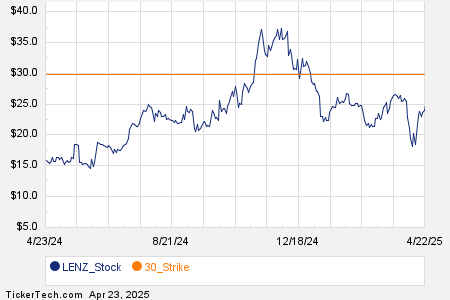Coffee Prices Surge: Arabica Hits 2.5-Week High Amid Supply Concerns
Today, July arabica coffee (KCN25) rose by +12.00 (+3.22%), while May ICE robusta coffee (RMK25) increased by +55 (+1.05%). Coffee prices are climbing, with arabica reaching a 2-1/2-week peak. The Brazilian real (^USDBRL) has gained strength, reaching a 2-1/2-week high against the dollar, which has complicated export sales for Brazil’s coffee producers.
Market analysts note that arabica coffee is also benefitting from insights by Rabobank. Their recent forecast suggests that Brazil’s 2025/26 arabica crop may drop by -13.6% year-over-year to 38.1 million bags, primarily due to dry conditions impacting flowering in key growing areas. In contrast, predictions for robusta coffee remain more optimistic, with estimates indicating a +7.3% increase to a record 24.7 million bags.
Additionally, the impact of subpar rainfall in Brazil is causing concern for overall coffee yields. Somar Meteorologia reported that Minas Gerais, Brazil’s main arabica-growing region, received only 17.9 mm of rain in the week ending April 12, marking just 89% of the historical average.
Current inventory levels are also influencing market sentiment. ICE-monitored robusta coffee stocks increased to a 2-week high of 4,272 lots as of last Thursday, while arabica coffee inventories reached a 6-week high of 806,181 bags earlier this week. This uptick in supply could exert downward pressure on prices.
Broader market dynamics are affecting commodity prices generally, including coffee. Concerns are arising that rising tariffs will diminish U.S. coffee demand, imposing higher prices on consumers.
However, fears surrounding supply constraints are providing support for coffee prices. Cecafe’s report from April 9 detailed a -26% year-over-year decline in Brazil’s green coffee exports for March, totaling 2.95 million bags. Furthermore, Brazil’s government crop forecaster Conab projected a -4.4% drop in the 2025/26 coffee crop to a three-year low of 51.81 million bags. They also revised their estimate for the 2024 crop downwards by -1.1% to 54.2 million bags.
Brazil’s top arabica coffee cooperative, Cooxupe, warned that high temperatures and lower-than-normal rainfall in the previous month would adversely affect coffee yields this year. As the world’s largest arabica coffee producer, Brazil’s output levels are crucial for the global market.
On the downside, Marex Solutions indicated on March 7 that they predict the global coffee surplus for the 2025/26 season to widen to 1.2 million bags, a marked shift from the previous year’s surplus of +200,000 bags.
Looking at longer-term challenges, the impact of the dry El Nino phenomenon from last year is creating concerns about lasting damage to coffee crops across South and Central America. Observations have shown consistent below-average rainfall since April, damaging the critical flowering stage of coffee trees and reducing prospects for Brazil’s arabica crop in 2025/26. According to Cemaden, Brazil is experiencing its driest weather since 1981, while Colombia is gradually recovering from the drought conditions caused by El Nino.
In terms of robusta coffee, reduced production levels are providing support. Vietnam’s output for the 2023/24 crop year fell by -20% to 1.472 million metric tons, marking the smallest harvest in four years due to drought conditions. Reports from Vietnam’s General Statistics Office showed a -17.1% year-over-year decline in coffee exports for 2024 to 1.35 million metric tons. The Vietnam Coffee and Cocoa Association also lowered its 2024/25 production estimate to 26.5 million bags from a prior estimate of 28 million bags. Additionally, the Vietnam Customs Department reported a -15.3% year-over-year drop in coffee exports from January to March, totaling 495,780 metric tons.
Reports of increased global coffee exports are contributing to bearish market sentiments. Conab announced on February 4 that Brazil’s coffee exports surged by +28.8% year-over-year to a new record of 50.5 million bags. Nevertheless, the International Coffee Organization (ICO) noted a -12.4% fall in global coffee exports for December year-over-year, totaling 10.73 million bags, with a slight -0.8% drop in exports from October to December.
The USDA’s biannual report from December 18 painted a mixed picture for coffee prices. The USDA’s Foreign Agriculture Service (FAS) projected a +4.0% year-over-year increase in global coffee production for the 2024/25 season, amounting to 174.855 million bags. This includes a +1.5% increase in arabica production (97.845 million bags) and a +7.5% increase in robusta (77.01 million bags). However, forecasts suggest that ending stocks for 2024/25 could fall by -6.6% to a 25-year low of 20.867 million bags.
For the 2025/26 marketing year, Volcafe has revised its Brazil arabica coffee production estimate down to 34.4 million bags, nearly 11 million bags lower than its September prediction following a crop tour that revealed severe drought conditions. This could lead to a projected global arabica coffee deficit of -8.5 million bags, an increase compared to the -5.5 million bags deficit observed in 2024/25, marking the fifth consecutive year of deficits.
On the date of publication, Rich Asplund did not have (either directly or indirectly) positions in any of the securities mentioned in this article. All information and data in this article is solely for informational purposes. For more information, please view the Barchart Disclosure Policy.
here.
The views and opinions expressed herein are the views and opinions of the author and do not necessarily reflect those of Nasdaq, Inc.

